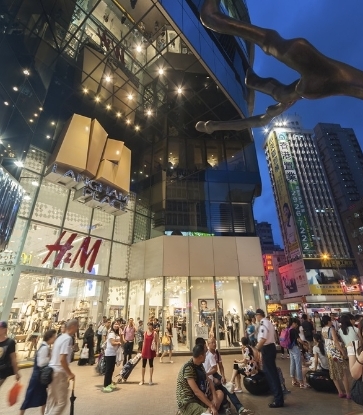Here are 10 chefs from Hong Kong's esteemed selection of Michelin-starred establishments to share their views on how the city's dining scene has changed over the past decade.

Executive chef, two Michelin-starred Duddell's
Open communication
"The Cantonese kitchen is all about structure and hierarchy; I would say 10 years ago the kitchen mentality was still a bit more rigid and conservative.
From luxury to sustainability
"10 years ago menus and dishes were very lavish and complex. Diners wanted impressive dishes using rare and exotic ingredients that take a long time to prepare. While we still have this expectation, across the board, our menus have become more simplified and specialised in particular flavours or regional cooking. People are looking for dishes they can go back to on a regular basis and won’t wear out or become outdated.
There’s also increased awareness in sustainably sourced and raised ingredients. We avoid things like shark’s fin and rare, endangered fish."

Richard Ekkebus
Culinary director, two-Michelin-starred Amber
More independent restaurants
"Back then, the city had a more classic vibe, and the good restaurants were usually in hotels. Things have changed, the city is more competitive now and restaurants have a way better quality in general."
"Lunch has always been about a value-driven set concept in general, but our clientele has changed and therefore the consumption has changed; we have seen a serious surge in leisure guests over the years so people come for lunch eat more than just 3 courses. At that time it was only 3 course lunch menus, and guests were out within an hour. Our largest menu for dinner was six courses at the time, but now the largest menu is 10 courses, so we are more of a destination restaurant now and the nine and 10 course menu makes up 85 per cent of our business."

Jacky Tauvry
Chef de cuisine, two Michelin-starred Pierre
More environmentally-conscious diners
"Since my arrival (in Hong Kong) five years ago, there has been a new trend of eating more healthy and sustainable goods, and people have started to be more respectful towards the environment."
"These days, a lot of restaurants have opened (and some of them closed). But it brings more competition, so it pushes us to be more creative, which is good for us but also, and more importantly, for our customers."

Executive chef – Chinese cuisine, three Michelin-starred T’ang Court
Need for grit
"There are less people entering the industry nowadays as compared to 10 years ago. Executive chefs nowadays need to spend more time in coaching the subordinates.
Rise of seafood
"People tend to eat more meat 10 years ago. Nowadays with more awareness on health concerns, people like to consume just a little meat, while seafood, which is supposed to be healthier, is getting much more popular nowadays."

"As I remember molecular cuisine has a strong presence 10 years ago and that has faded out significantly. In Hong Kong 10 years ago there were a lot of private kitchens as well, those have moved to warehouse spaces nowadays."

Executive sous chef, two Michelin-starred Ming Court in Cordis, Hong Kong
More schools for young chefs
"10 years ago, there was a lack of channels to start career working in Chinese Kitchens. Most were referred by friends whom were working in the kitchen."
"Nowadays, young people can enroll themselves in vocational training schools.
Lighter flavours for the palate
"Guests preferred strong flavours 10 years ago. Now they are more health conscious and look for dishes with less oil and less salt. Also the plating for Chinese cuisine is more sophisticated and innovative than it was in the past."

Guillaume Galliot
Chef de cuisine, two Michelin-starred Caprice
Inspired by travels
"(Chefs) now get to travel more often and that helps with keeping the inspiration flow. Say for example, for last year’s Michelin Gala in Macau, I created a dish inspired by Singapore’s famous laksa (Alaskan snow crab salad with laksa foam).
The iPhone generation
"On top of being up for trying new things, more and more young people appreciate fine dining thanks to social media and venerable food distinctions like the Michelin itself. Fine dining has always been very simple to me, it is for everyone who loves food. It has evolved to be more than just a dining experience but a lifestyle choice.
At the same time, because everyone likes to whip out their phone for a photo before they dig in, chefs need to make sure that the temperature of the dish is on point. Even after leaving it on the table for a while, the dish still remains hot."

Executive chef, one Michelin-starred VEA
Treasure the classics
"I don't think there has been a major change in the types of cuisine people enjoy, but what we do see less and less of now is classical techniques being employed in restaurants. Some traditional dishes, like a whole deboned duck or pigeon for instance, are so labour-intensive that not so many chefs do them anymore."
"Last time, I remember working in restaurants where there would be a bulletin board with pictures of local food writers/inspectors stuck on it so everyone in the kitchen could take note. But these days, anyone with a camera or an iPhone can be a judge now by taking a picture of your food and commenting on it."

Executive chef, three Michelin-starred Lung King Heen
More recognition for Cantonese cooks
"With the arrival of the MICHELIN guide 10 years back, Cantonese cooks in Hong Kong finally got the recognition they deserved from a wider audience.

Hidemichi Seki
Chef de cuisine, two Michelin-starred Tenku Ryugin
More diners from overseas
"At the beginning, when I came to Hong Kong, majority of customers were local. But now, other than local customers, there are far many more overseas travellers who come for a degustation experience.
The story behind each dish
"Ten years ago, probably the dishes and cuisine were all about luxurious, premium quality ingredients. But now, more people focus on the character and personality of the cuisine — the inspiration and the story behind the making of a dish."





















